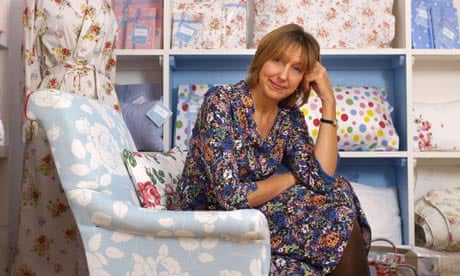First it was just the tea towel and cute polka-dot plates, then the sewing box and tent. Now the unchecked growth of floral print is taking over the high street, according to new figures.
Sales and profits have jumped more than 60% at Cath Kidston, the purveyor of "kitchenalgia" that has become as much a part of the (chintzy) fabric of British life as the late Laura Ashley.
Accounts filed at Companies House reveal profits at the fashion retailer increased from £2.9m to £4.6m in the year to March, as its rosebud-covered ironing boards and floral biscuit tins proved a tonic for recesssionistas.
While not everybody's cup of tea, the eponymous designer's heavy floral prints have become as ubiquitous over the last 10 years as Ashley's romantic prints were in the 70s.
Sales have grown at break-neck pace for Kidston, increasing from last year's £19.2m to £31.3m as new stores opened around the country and the retailer made its first attempt to crack the Irish market.
Kidston's teapots and oilcloths, which embrace the image of the 1950s housewife, celebrating baking, afternoon tea and knitting, have become addictive for a generation of women whose busy working and home lives have led them to idealise rather than practise domesticity.
"Cath Kidston is the new Laura Ashley," claimed Lorna Hall, the retail editor of the fashion trends website WSGN. "The brand keys into the same aesthetic, with its dreamlike nostalgia. For many women it is a way to nest, without all the hard work involved in nesting."
Kidston is not just a "global lifestyle brand" she's a real woman (and cousin of the style guru Kirstie Allsopp) who says her childhood "of ponies, boarding school and a rambling house on Hampshire/Wiltshire borders" provides the palette for her stores.
The vintage fabrics and brightly-painted junk furniture sold at her first Kidston store, which opened in 1993, proved an instant hit with "yummy mummies" at the shop's location, in London's Holland Park. The success encouraged the designer to create her own signature products. One of the first designs, for an ironing board cover – practical, quirky, with a distinctive floral print – came to epitomise the "Cath Kidston look" and its desire to put a cheery spin on day-to-day chores.
"We work hard to ensure that our products are pretty, practical and affordable," said Kidston, of the brand's success in the teeth of the economic downturn. "We also try to make the shopping experience fun and light-hearted, which we hope will give our customers a reason to be cheerful regardless of the economic climate."
Breast cancer in her mid-thirties encouraged Kidston to give up interior design and devote herself to what would become Cath Kidston Inc. Over the last 15 years the flowery empire has spread like ivy. Her dots and roses are now wallpapered over everyday items, ranging from Tesco carrier bags, to Sky boxes and Roberts radios. There is also a Cath Kids clothing brand.
There are 27 Cath Kidston stores in the UK and Ireland, with 10 new openings in the last year. The prints have caught on in Japan, where Tokyo, Nagoya and Yokohama have outlets, though a foray into US market was less successful.
But Kidston has not been alone in selling nostalgia on the high street. This year retailers, ranging from Marks & Spencer to Sainsbury's, have run heritage campaigns, trying to coax shell-shocked consumers to part with the cash. "Nostalgia always becomes more important when times are tough," said Steve Sharp, marketing director of Marks & Spencer.
Kidston's success defies a dowdy high street, where homewares retailers have been among the hardest hit – many purchases in this sector are triggered by people moving house or sprucing up before selling. Amid a frozen property market, homewares chains as a group endured 12 consecutive months of sales declines, according to the accountancy firm BDO Stoy Hayward. BDO said the "rot" stopped in July, when sales turned positive, climbing 1.2% and reflecting the recent pick-up in the property market.
This year's bumper results saw shareholders in Kidston, a privately owned business, reap a £1m dividend. The retailer has no debt and, if sold, Cath Kidston, who remains a major investor, would be in for a substantial windfall. Indeed it would seem the only threat to her empire is overload. "She's got to be careful not to venture too far beyond the brand's comfort zone because ubiquity is what felled Laura Ashley in the 90s," said Hall.
